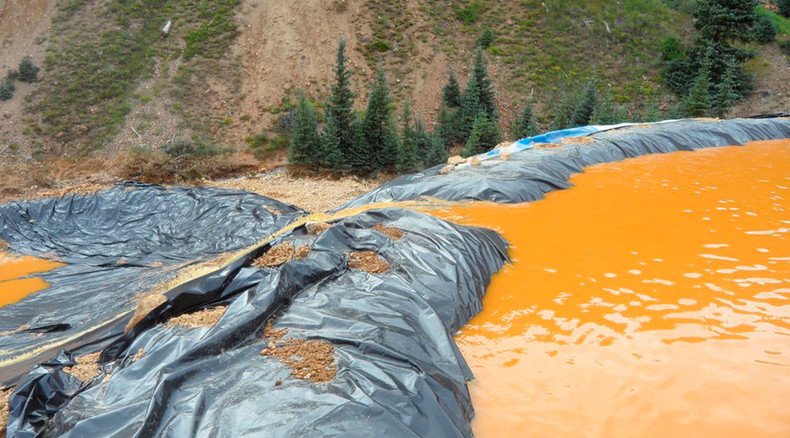As Native American tribes are struggling to cope with a toxic spill caused by an Environmental Protection Agency contractor that turned a river in Colorado orange, a letter from a retired geologist has emerged, that warned of the risk a week beforehand.
A contractor for the EPA released some three million gallons of toxic mining sludge on August 5 while attempting to clean up an abandoned mine near Silverton, Colorado. The waste flowed into Cement Creek, and has since contaminated the Animas River, San Juan River, and the Colorado River in Utah.
The Southern Ute Indian Tribe in southern Colorado has declared a state of local emergency. Their 1,059-square-mile reservation was the first to be hit by the spill, a 100-mile-long stream of mining waste containing lead, copper, and arsenic. Classifying the spill as a disaster enables the release of aid and recovery funds.
“The cost and magnitude of responding to and recovery from the impact of the water contamination from the Gold King Mine Animas River Spill, caused by the EPA on August 5, 2015 is far in excess of the Southern Ute Indian Tribe’s available resources,” the tribe said in its declaration, quoted by Indian Country Today.
Further downstream, the Navajo Nation is fighting the EPA over the agency’s damage claims form. The tribe’s attorney general says Standard Form 95 contains “offending language,” waiving all claims to future compensation.
“Once the claim is made it will only be for the claims suffered to date and precludes future claims,” Navajo Nation president Russel Begaye said, ordering all tribal agencies to stop advising residents to use the form.
EPA Administrator Gina McCarthy visited Durango, Colorado earlier this week, but declined to travel to the disaster site, according to the Denver Post. Agency officials said the mine was “too far” to visit, involving a 55-mile trip, partly over unpaved roads.
“As you know, it is a significant distance away, but I did visit the river. I took a look at it myself to get a sense of the river,” McCarthy said. “And I think the good news is it seems to be restoring itself, but we have continued work to do and EPA is here.”
Originally estimated at 1 million gallons (3.785 million liters), the spill was later confirmed to have involved at least three times that amount of toxic waste. Among the metals detected in the sludge were arsenic, cadmium, copper, beryllium, iron, lead, mercury, and zinc. The recorded lead levels alone were 12,000 times higher than normal.
Five water supply systems have been affected by the spill. While the river system mostly serves farming communities, the disaster also poses a risk to the drinking water of 17, 000 people living in Durango, Colorado and 45,000 residents of Farmington, New Mexico.
While the agency has maintained that the release of toxic sludge from the Gold King mine was an accident, one retired geologist speculated the EPA might have been setting the area up for a disaster in order to get more federal funding.
“Based on my 47 years of experience as a professional geologist, it appears to me that the EPA is setting your town and the area up for a possible Superfund blitzkrieg,” Dave Taylor of Farmington wrote in a letter to the editors of the Silverton Standard, published July 30. The paper confirmed the letter’s authenticity in a blog post on August 12.
The EPA’s grand experiment to plug the Red & Bonita mine might seem to work at first, Taylor wrote, but he predicted the water would find a way out and “exfiltrate uncontrollably through connected abandoned shafts, drifts, raises, fractures, and possibly from talus on the hillsides.”
Taylor further anticipated that all of the water flow would return to Cement Creek within anywhere from a week to 120 days and could even increase the contamination.
“Reading between the lines, I believe that has been EPA’s plan all along. The proposed Red & Bonita plugging plan has been their way of getting a foot in the door to justify their hidden agenda for construction of a treatment plant,” he wrote.
The EPA has been lobbying to designate the area as a recipient of federal Superfund financing, but met opposition from local residents, Breitbart confirmed. The Wall Street Journal identified the contractor hired to plug the Red and Bonita mines as Environmental Restoration, LLC of Fenton, Missouri, a recipient of over $380 million in EPA contracts over the past decade.
Colorado governor John Hickenlooper visited Durango on Wednesday and took a sip of water from the Animas River in a publicity stunt. An iodine tablet which he used to purify the water would have killed any bacteria and parasites, but had no effect on the heavy metal pollutants. Residents were advised not to follow the governor’s lead, though, as the water was considered unsafe for drinking even before the spill, the Durango Herald reported.

